ARCHAIC GREEK WARFARE: THE HOPLITES + THE PHALANX
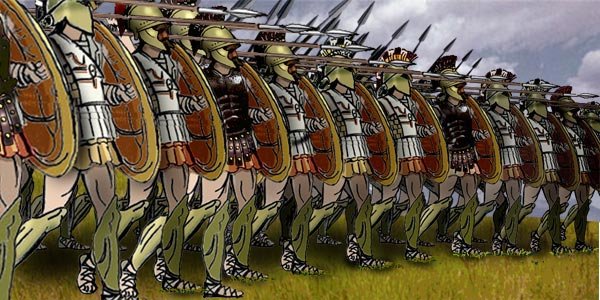
(ABOVE: Drawing of a hoplite phalanx in battle formation)
War exists in all. A warrior’s status in Archaic Greece, and his parts to play in justifying and maintaining a collection of economic benefits, ethical values and political institutions, are already clear. Metal trading, and its importance to those involved in it, were the symptoms of the military’s expanding technology. In turn, this was crucial for the Greeks successful colonisation as they met tough and unfamiliar opponents across the Mediterranean. At the turn of the 7th century BC, in terms of supplies of raw materials and metal production skills and capacities, the Greek world’s economic base for weapons manufacturing was stable enough to allow for the breakthrough of a new form of warfare; where before the Greek world had vast unorganised armies lead by champions, these new heavily armoured troops became the most effective military force in the Mediterranean, dominating the sea without much of a need to change their ways for centuries to come, and influencing other cultures around them in the process, until the rise of Macedon under Philip and Alexander, and eventually until the rise and conquests of Rome. The military changes at the end of the 8th century BC in terms of weaponry, tactics and military personnel in turn brought further changes to social morality and politics.
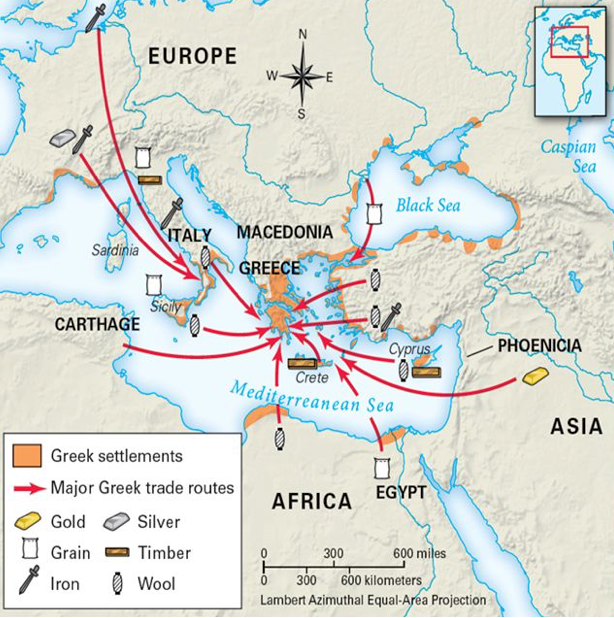
(ABOVE: Trade routes, including metals, across the Mediterranean with the Greeks)
AN EMERGING CITIZEN ARMY
The 6th century BC polis was commonly reorganised to produce vast bodies of trained military men, who would come to dominate politics. Political honours were arranged according to the property men owned, and shared on some level by those who could afford to bare their own armament and panoply. While later on this criteria would seem to be somewhat restrictive, it was actually a very wide group, being made up of peasant-farmers who owned at least some of their own land; in most states, this included roughly at least the upper third of the free adult male population. Depending on the size of the city-state, this allowed for a polis army comprised of anywhere between 3,000 and 8,000 fighting men at any one time, and these men would dominate politics of the leading states in several ways. It became the moral, social and political duty of a polis citizen to fight for his country during wartime. Any male citizen was viable for military service from the age of 20, and remained in the muster role for around 40 years until retirement. Desertion from the army could result in the individual loosing his citizenship. To demonstrate that ALL male citizens were at one point soldiers, even the Athenian poet Aeschylus stood in the armies ranks for most of his life; his grave even states that he wished to be remembered as a warrior, and not a tragedian.
THE HOPLITE AND HIS ARMAMENT
The new soldier that emerged from all this change was called the Hoplite. These men were armed with standardised equipment: bronze shin guards (greaves) and corslet, a bronze helmet designed to provide maximum protection to the head and face while still allowing for decent vision ahead of the wearer, and a heavy convex circular bronze-covered wooden shield called the hoplon, giving the soldiers their name of hoplite.
SHIELD: THE HOPLON
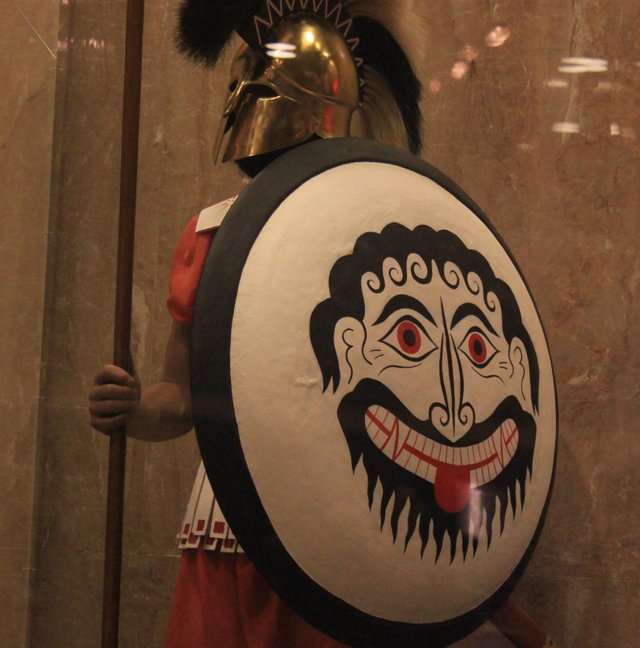
(ABOVE: A decorated hoplon shield, covering the user from thigh to neck)
The Greek word for shield is "aspis", and the aspis donned by the Hoplites gave them their name; The hoplon, mostly made of either poplar or willow wood, was backed with leather, and held securely by the user by placing his left forearm through a hoop and holding onto a grip near the shield’s rim; At the advent of hoplite warfare, this was a breakthrough in the military, and was known as the Argive Grip. The strap itself was called a “porpax”, and the handle was called an “antilabē”. Spartans of the 5th century onwards were known to paint on their shields the Greek letter “L” (“Λ”), which represented their homeland of Lakedaimonia in the southern Peloponnese.
Hoplons were wooden and had a bronze rim, and later a bronze covering. This bronze face was usually decorated with imagery. Its decoration usually consisted of geometric or figured blazon, painted or applied bronze. The Argive Grip is what separated this shield from any other before it. The Argive Grip allowed for more of the users arm to control the shield and give it more leverage, meaning the shield could be heavier. The grip also dictated that the shields total diameter should be around twice that of the user’s forearm, and they tended to be 1 metre in diameter. It also meant that the shield was more capable of allowing the user to push at the enemy in front of them, as it could be moved around less easily. And since it turned a lot less when a weapon impacted it, blows tended to be more frontal and piercing instead of glancing, as it guarded a lot of space to the left of the soldier. While all of these attributes made the hoplon less adapt for single combat, they made it far better for close formation combat. An early pottery design from 685 BC clearly shows the inside of a shield as it is wielded by a hoplite, detailing the strap and grip.
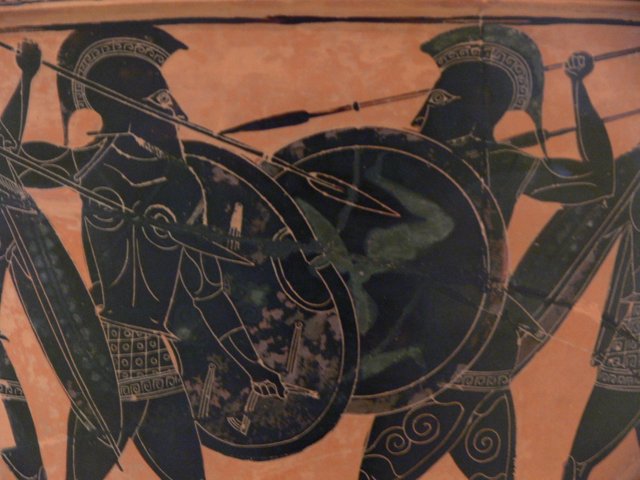
(ABOVE: Vase painting showcasing hoplites in combat, also detailing the inside of a hoplon)
HELMET: THE CORINTHIAN HELMET
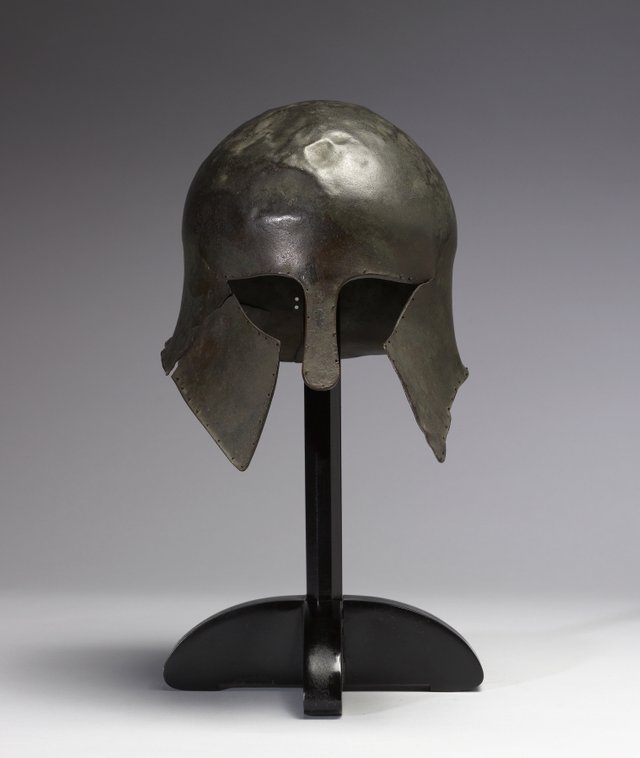
(ABOVE: An undecorated Corinthian helmet)
The helmet was lined inside with leather, fixed to the interior via small pierced holes in the metal. Under the helmet, a soldier may have worn a headband to provide some extra support for the helmet whilst also tying back their hair. The discomfort of wearing such a helmet all the time was countered by the fact that the helmet could easily be lifted and balanced well on top of the head when the soldiers were not in combat. It’s in this position that the helmet mostly appears when shown in iconography, imagery, pottery and coins.
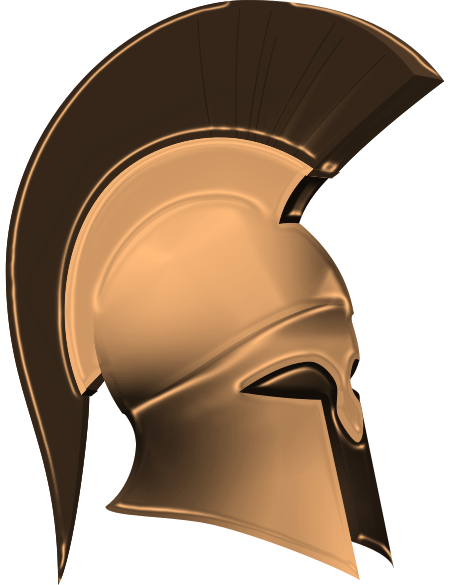
(ABOVE: Digital recreation of a Corinthian helmet with horsehair crest)
BODY ARMOUR: THE BREASTPLATE / CORSELET
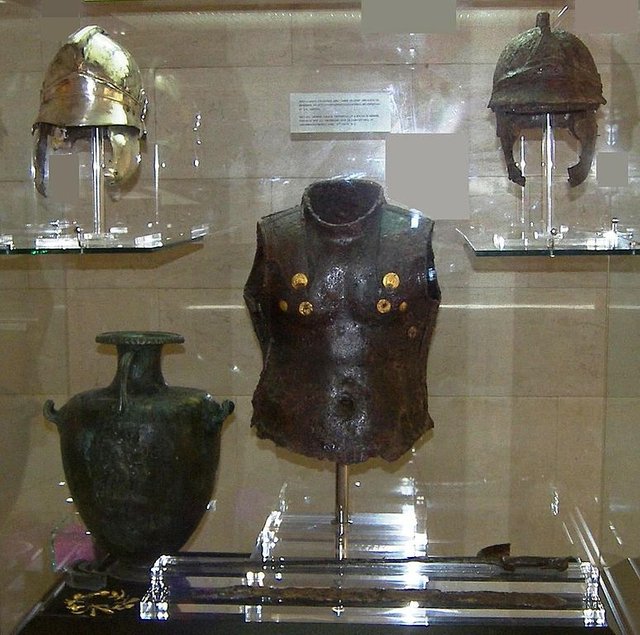
(ABOVE: A Greek bronze breastplate, alongside some helmets and swords)
The corselet, made of either linen or bronze, protected the wearer’s torso. Later versions of the corselet were made of multiple layers of linen glued together with resins, which formed a stiff coverage of roughly 0.5 cm’s thick. Below the waist, the corselet was cut into strips (“pteruges”) to allow for easier movement, and a second layer of pteruges was fixed behind this outer layer, which covered the gaps formed by the outer pteruges and formed a kilt-like skirt that provided some groin coverage. The linen corselet (linothōrax), which first appeared in c.525 BC, was far more comfortable, flexible and cooler than its sculpted bronze counterpart when worn under the hot sun. The bronze corselet though provided better coverage against glancing blows, but a more direct and piercing hit would pierce through, which is why it was commonly worn with padding underneath.
GREAVES: THE KNEMIDES
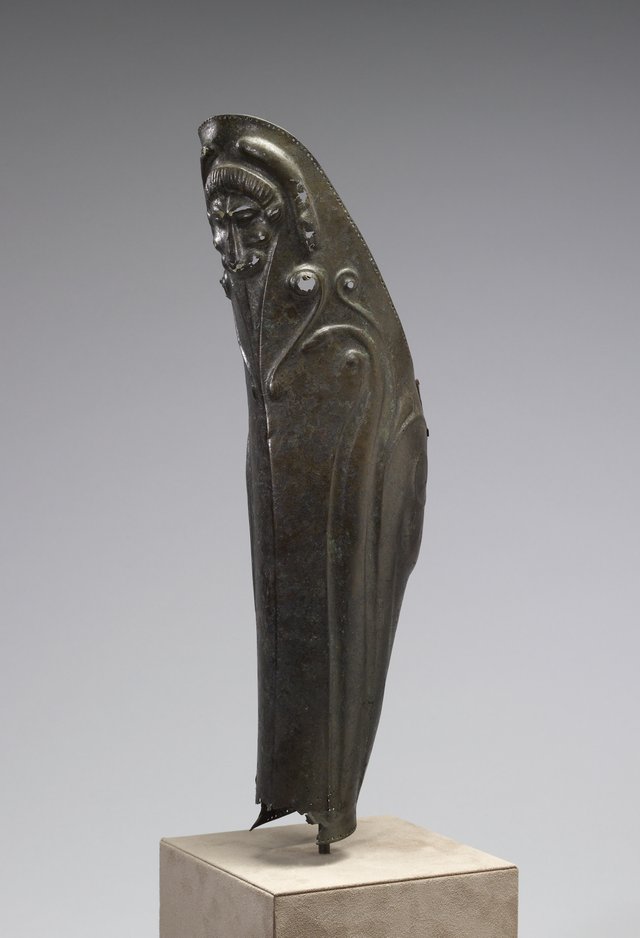
(ABOVE: Decorated bronze knemides)
Finally, the bronze greaves (“knemides”) protected the lower legs. These were clipped around the shins via their own elasticity. And thus, with the full helmet, corselet, greaves and a shield in front covering them from thigh to neck, the hoplite was virtually covered in armour, and very hard to take down.
Where the shield and helmet remained fairly consistent in their design, the body armour of hoplites does seem to have made changes before and during the widespread use of the phalanx, telling us that the body armour was not as important as the shield and helmet, which already provided large amounts of protection together. Altogether, the kit a soldier carried weighed around 30 kg, with the shield itself weighing around 7 kg.
WEAPONS
For offence, the hoplites carried into battle a spear roughly one and a half times a man’s height, called a Doru, and a short sword for closer ranged combat.
SPEAR: THE DORU
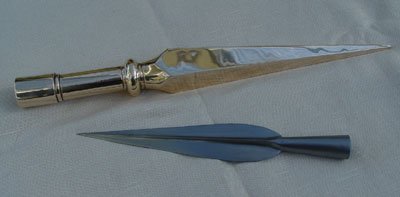
(ABOVE: An iron leaf-shaped spear head [below] and a bronze butt-spike [above])
Doru were made of ash wood and typically measured between 2 and 2.5 metres in length. It was tipped with a bronze, and later: iron, leaf-shaped spearhead and a bronze butt-spike made the weapon double-edged and provided a counter-balance when holding the spear closer to the bottom. The butt-spike was often called the ‘Lizard Killer’, (“Sauroter”) and allowed the spear to be planted in the ground to finish off wounded enemy or to change weapons when ordered to. Being made of bronze allowed it not to rust when placed into the ground. The common grip for fighting in a phalanx formation was overhand, with the spear tip pointing directly towards the foes face, although underarm grips were commonly used, especially when facing against an opponent quickly charging towards them. The middle of the spear’s shaft was wrapped in a leather cord to improve the grip.
SWORD: THE KOPIS (+ XIPHOS)
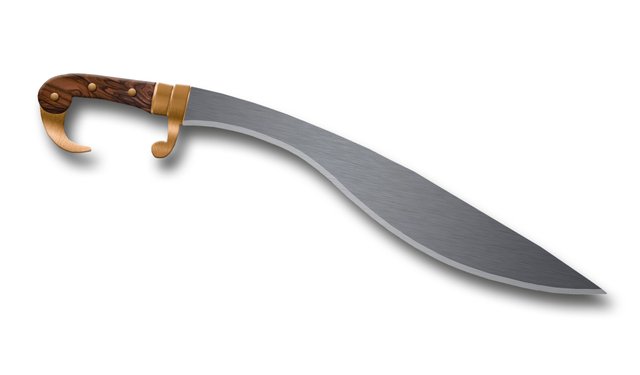
(ABOVE: The Kopis sword, used by hoplite foot infantry, but often also used by cavalrymen in some parts of Greece)
The sword (“kopis”, meaning “cutter”) was a heavy, single-edged blade made to be slashed overhand. Both edges were convex, which weighed the sword more towards the tip. Every hoplite carried a kopis, but it was very much a secondary weapon. The Spartans were famous for using the Xiphos sword, however, which was much shorter and almost resembled a dagger more than a sword. They believed it got them even closer to the enemy. In fact, when once a Spartan was jokingly asked by an outsider why his sword was so short, he replied, “it’s long enough to reach your heart”.
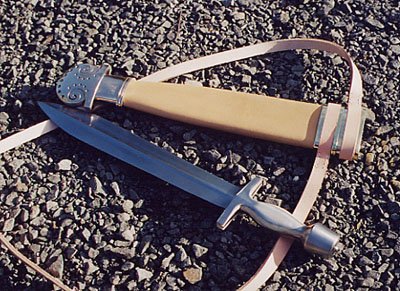
(ABOVE: Modern recreation of a Xiphos sword + scabbard)
FORMATION: THE PHALANX

(ABOVE: A Greek hoplite phalanx marching into battle)
The heavy armour and poor visibility was a disadvantage, but this was balanced out by the way hoplites fought together in war; A phalanx formation (phalanx meaning “stacks” or “rows”) consisted of soldiers interlocking their large shields with the man next to them; as the soldier held his shield via the Argive Grip, holding it with his left arm at the right side of the shield, the right half of his shield covered himself, leaving the left side to cover the man standing to his left. When each soldier overlapped the right side of their shield with the left side of the man standing to their right, this created a scale-like shield wall reinforced by this overlapping of the shields. This created a more brotherly bond in combat, as soldiers were reliant on each other to keep a strong formation. This was then further reinforced by the fact that a phalanx consisted of several rows of these soldiers all interlocking their shields, to combine maximum push with the desire to not be outflanked. The normal arrangement for a hoplite phalanx was anywhere between 4 to 12 ranks deep, spending on the situation and needs at the time of deployment. Essential on top of all this though was an iron will from all men to hold their formation, or else risk a potential break in the shield wall. This was reinforced by the men training together, and brigading together according to localities so all the men fighting together knew each other better.
The tight formation of the phalanx made it an unsuitable form of warfare for fighting on uneven terrain, so opposing hoplite armies would usually seek out flatter terrain first; rigid military thinking was well demonstrated by the fact that Greece itself is such a mountainous and hilly part of the world. It is therefore arguably a better suited battlefield for light troops and guerrilla warfare, something that wouldn’t emerge en mass until the late 5th century BC. Some phalanxes were kept on beat and in formation by flute players, a common sight in Spartan armies. A disadvantage of the shields overlapping to the left was that the men on the far right of the formation were very exposed in comparison to everyone else. To combat this somewhat, hoplite phalanxes often placed their most experienced fighters on the far right. In Sparta, the right side of a phalanx was considered a position of honour. It was also because of this overlapping to the left that caused phalanx formations to commonly drifted forward to the right as everyone tried to get more behind their neighbours shields, and generals often had no control over this happening. A solid wall of interlocked shields, together with rows upon rows of spears, also made the phalanx very adapt at fending off a good cavalry charge, something which other infantry would usually be very vulnerable to.
A group of soldiers together in phalanx formation was called a “panoply”, (“panopliā”), and Spartan panoplies were famous for advancing slower and more in step and order than other poleis, marching to the rhythm of the flute and singing war songs, which contrasted everyone else who, as Thucydides notes, marched into battle “full of sound and fury”. The war cry before battle, the Greek “paean”, was Doric in origin, and was known as a “sacred cry uttered in a loud voice… a shout offered in sacrifice, emboldening to comrades, and dissolving fear of the foe”. The Spartans were also known to wear leaf crowns, at least while they had stopped to perform their own “blood sacrifice” war cry. It wasn’t uncommon for opposing phalanxes to actually flee and run in sight of these Spartan war cries even before combat had ever begun.
COMBAT
Pushing and shoving was in essence the main part of how phalanxes actually fought each other. Opposing armies would push at each other’s shields while stabbing above and below with their spears and swords. As soldiers fell, the man behind would trample over him to make his way to the front rank. Eventually one side would buckle, break formation and begin to flee, often leaving their heavy shields behind to make a quicker escape. In many states, most notably in Sparta, it was considered a huge dishonour to abandon your shield in a fight, as the shield provided structure and protection to more than just one man. If cavalry was not present at a fight, pursuits in routing down fleeing enemy was minimal, otherwise armies light and disorderly enough to run after a fleeing force might in turn invite their opponents to regroup and fight again. This, however, was not an uncommon occurrence at the time. Victorious armies were content afterwards with possession of the battlefield, stripping weapons, armour and goods off of the fallen, burying their fallen comrades, killing or selling off the wounded as slaves, and setting up a trophy. The result from this style of warfare was mostly minimal casualties, since really only the front row of soldiers were the ones in danger, and flight, while a disgrace, was an easy thing to do.
It was indeed a very effective form of combat, as even larger armies with less cohesion than a phalanx would crumble easily under the sheer discipline and strength of the hoplites in formation, but it was also deadly when two hoplite walls faced off against each other. This toe-to-toe form of fighting was known to the Greeks as the “law of hands”.
ARMOUR + TACTICS - SUDDEN OR GRADUAL CHANGES?
This new form of fighting greatly affected Greek society as a whole, however it’s not so easy to see exactly how these changes came to be. Armour and tactics might have been interdependent in some way, as more and heavier armour encourages closer and more static forms of combat. yet there is controversy over the exact nature of this relationship, leading to two separate theories: that the change can be dated to be one of gradual development, and that it can be dated to be one of quick and instant change.
THE CHANGES IN ARMOUR
Greek armour and weapons certainly had a gradual change; the 11th century BC saw the use of iron swords and spear tips, and there is no clear break in their development during that time. The sword would gradually get shorter over time, better suiting the close quarter style of hoplite warfare. Spears during the Dark Age seem to have been more commonly for throwing, and there doesn’t seem to be much evidence pointing towards a great difference between these spears, thrown with the aid of a leather thong, and the later hoplite ones. Bronze corsets hinged down on one side, and were fastened at the other and on the wearers shoulders. These were moulded to fit the wearer, but enlarged at the hips to allow for a greater range of movement. The earliest example of such armour known to us dates back to c.725 BC, Argos, teamed with a helmet with a crest and welded side pieces of a pre-hoplite type. It’s unknown if this armour was originally buried with anything else at the time, but it’s likely this armour, due to the ornate design of the armour, point towards it dating to a time before the coming widespread use of the hoplites. Breastplates weren’t common in the Middle East due to the discomfort of wearing one in the vast heat, but the tradition of wearing breastplates was far more common in Europe; it’s a common theory that the same trade routes which brought metal into Greece also brought the breastplate, perhaps as early as c.750 BC. On the contrary, greaves seem to have no clear prior-used alternative, and seem to have come into creation during the 7th century BC.
HELMETS + SHIELDS
The helmets and shields of hoplites are arguably their most distinctive features. The origins of the Greek helmet design are in fact eastern: the horsehair crest is eastern, and both ideas may have originally come from Assyria, whose empire stretched to the eastern Mediterranean coast during the second half of the 8th century BC. Assyrians too used big round shields, partially supported by straps worn around the neck. Greeks believed that the Carians of south-west Asia Minor were the first to develop the hoplite-style helmet and shield; they claimed it was in fact they that first developed the horse-hair crest on the helmet, decorate their shields and fit handles to the inside of their shields. While they did definitely possess hoplite troops by the mid-7th century, but archaeology has revealed these developments were Greek first. The most common, and arguably most iconic, Greek helmet came from Corinth: the Corinthian helmet. shaped from a single piece of bronze, it provided maximum protection to the head and face of the wearer, allowing for just small eye slots and a gap for the mouth, with even a piece protecting the user’s nose. Its first appearance can be attributed to its earliest appearance on vases, dating to around 700 BC. It’s unlikely to have been popular prior to close-quarter hoplite warfare since it forced the wearer to restrict their vision more forward instead of anywhere else, unsuitable for one-on-one champion-style fighting. Hearing through it was near impossible, vision was restricted, and despite its inner leather covering, it was uncomfortable to wear.
It’s not until 675 BC that the first imagery of a hoplite with the full kit and equipment can be seen; It seems clear that all these pieces that made up the full hoplite armour came in gradually, piece by piece. The helmet and shield, however, must have had a closer link to the birth of hoplite warfare; the limited visibility matched with the lumbering shield make it nearly impossible that hoplite warfare could have developed before these two pieces of armour came to be widely used. Therefore, the late 8th century BC is the time dedicated to the earliest date of hoplite warfare being used.
[Herodotus, The Histories, 7.9]
(Mardonius addresses Xerxes) "Besides, from all I hear, the Greeks usually wage war in an extremely stupid fashion, because they are ignorant or incompetent. When they declare war on each other, they seek out the best most level piece of land, and that’s where they go to fight. The upshot is that the victors leave the battlefield with massive losses, not to mention the losers, who are completely wiped out.”
The hoplite phalanx came to be adopted by several other non-Greek cultures around the Mediterranean due to its effectiveness, which even included none other than the Romans, who adopted the hoplite phalanx before reforming their army to the more familiar sword and javelin armed maniple legions for around 200 to 300 years.
SOURCES
• Herodotus's "Histories"
• Oswyn Murray's "Early Greece"
• Robin Osborne's "Greece in the Making, 1200 - 479 BC"
• Nic Fields' "Thermopylae 480 BC, Last Stand of the 300"
(Here's a few links to some videos done by YouTuber "LindyBeige". I do NOT own this content, but thought it might be an idea for you to get an opinion from someone who's actually worn and used (NOT harmfully of course!) the armour and weapons of a Greek hoplite - enjoy!)
ASPIS / HOPLON
CORINTHIAN HELMET
LINOTHORAX
GREAVES / KNEMIDES
HOPLITE SWORDS
THE KOPIS
WEARING HOPLITE ARMOUR
HOPLITE WARFARE / SHOVING
All images used are license-free